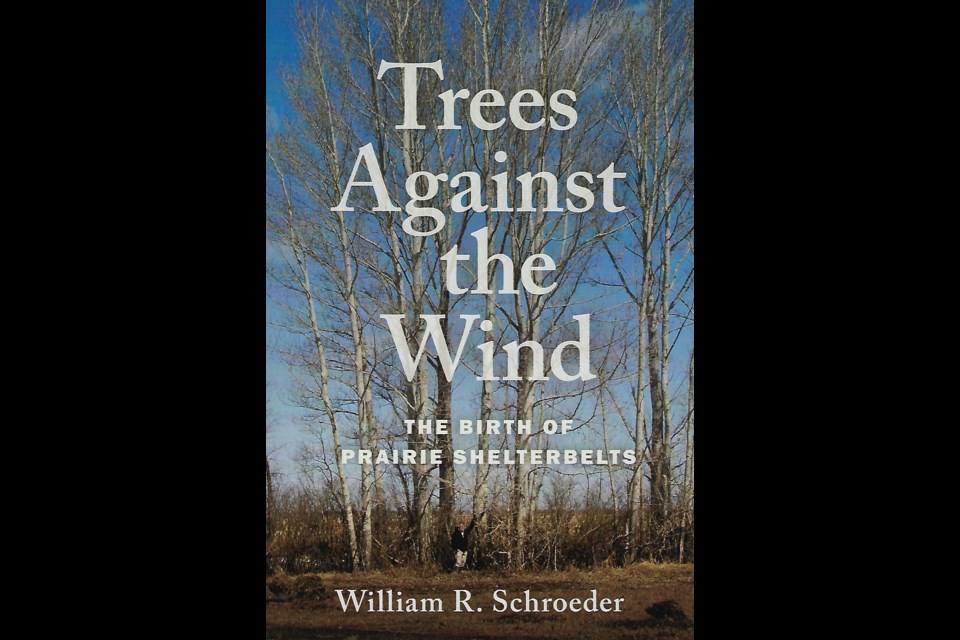Just off the press, "Trees Against the Wind: The Birth of Prairie Shelterbelts" is a treasure for those interested in trees as well as a great read for history buffs. William Schroeder has done an excellent job of documenting the life and times of those involved in tree planting, from the settlement of the Canadian West in the early 1900s until the shut-down of the Prairie Shelterbelt Program in 2012.
William Schroeder, a scientist with expertise in tree genetics, retired from his position with Agriculture and Agri-Food Canada, Agroforestry Development Centre in Indian Head in 2016. During his 35-year tenure, he was a world leader in breeding woody plants and pioneered sea buckthorn (Hippophae rhamnoides) research. His work at Indian Head awakened his interest in the history of tree planting. He subsequently spent many hours at Indian Head, Regina and Ottawa delving into the history of tree planting on the prairies and documenting the stories he had heard at his workplace.
The Dominion of Canada realized that to settle the West and make the prairies more attractive to pioneers, it was necessary to grow trees, to protect crops, gardens, livestock, people and buildings from the often cold, relentless prevailing winds. The tree nursery near Indian Head grew up during this time of British Colonization and provided free trees to homesteaders. The plum jobs, those of foremen and inspectors, were typically awarded to British subjects and the menial work delegated to those of other ancestries, mainly the inhabitants of 'Germantown' in Indian Head. Schroeder documents the trials and tribulations of holding onto a reliable workforce in the face of hard work and low wages. Inspectors travelled extensively across the prairies, ensuring that farmers prepared the land properly before any trees were shipped out. They travelled mainly by trains, which may have run once a week or so. But they almost always had to rent horses and buggies at the train station to continue their journey to extensive rural areas beyond those reached by rail.
As a volunteer interpreter for the Saskatoon Forestry Farm Park (the former Sutherland Nursery Station), you might have expected me to be bored with the subject. But I found many gems of new and unusual information.
Who knew that communities like Biggar, Saskatchewan, held tree-planting contests? To qualify, a shelterbelt needed to be a minimum of a half-acre and consist of at least one thousand trees. Farmers could enter two categories - The Best Shelterbelt or - The Best Prepared Plot. The response to these contests was enthusiastic and results were published in local papers. In 1926, the Best Shelterbelt won the grand prize of $50.00.
Although I knew about the tree-planting rail car that travelled from April to November as part of a passenger train and was dropped off at towns along the way, I did not know it was set up as a travelling theatre with long rows of seats and a screen at the front. "During a typical session, visitors viewed a travelogue of films highlighting all parts of Canada, followed by the film Tree Planting on the Prairies, which was commissioned by the Forest Nursery Station in 1919. The film was a highlight for viewers; many had never seen a talking film before." The tree-planting car was in service from 1920 to 1973. Today it can be seen at the Manitoba Agricultural Museum, where it continues to educate the public about tree planting on the prairies.
It was great to hear another voice on the subject of shelterbelts - those rows of trees that reduced the winds, making a house a home, and how they came into being. I found the book to be informative, well researched and an entertaining read.
Thank you, Bill, for preserving this little-known part of Prairie history.
Trees Against the Wind is available from Nature Saskatchewan's online store, McNally Robinson and Wild Birds Unlimited in Saskatoon.
This column is provided courtesy of the Saskatchewan Perennial Society (SPS; [email protected] ). Check out our website (www.saskperennial.ca) or Facebook page (www.facebook.com/saskperennial).
Keep your news a touch away by bookmarking The News-Optimist homepage at this link.




